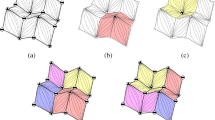Abstract
This paper describes a hierarchical visibility technique that significantly accelerates terrain rendering. With this technique, large parts of the terrain that are hidden from the viewpoint are culled, thus avoiding the expense of uselessly sending them down the graphics pipeline (only to find in the z—buffer step that they are hidden). The hierarchical visibility technique has been implemented in a multiresolution terrain rendering algorithm and experimental results show very large speedups in some situations.
Access this chapter
Tax calculation will be finalised at checkout
Purchases are for personal use only
Preview
Unable to display preview. Download preview PDF.
Similar content being viewed by others
References
P. Lindstrom, D. Koller, W. Ribarsky, L. F. Hughes, N. Faust, and G. Turner, “Real-Time, continuous level of detail rendering of height fields”, in Computer Graphics (SIGGRAPH ‘86 Proceedings). ACM SIGGRAPH, August 1996, pp. 109–118, held in New Orleans, Louisiana, 04–09 August 1996.
L. De Floriani and E. Puppo, “Constrained Delaunay triangulation for multiresolution surface description”, in Proc. Ninth IEEE International Conference on Pattern Recognition,Los Alamitos, California, 1988, pp. 566–569, CS Press.
L. Scarlatos and T. Pavlidis, “Hierarchical triangulation using terrain features”, in Proceedings of the 1st 1990 IEEE Conference on Visualization, Visualization ‘80,IEEE Service Center, Piscataway, NJ, USA (IEEE cat n 90CH2914–0), 1990, pp. 168–175, IEEE.
M. H. Gross, R. Gatti, and O. Staadt, “Fast multiresolution surface meshing”, in Proceedings of Visualization ‘85, October 1995, pp. 135–142.
J. J. Koenderink and A. J. van Doom, “The singularities of the visual mapping”, Biological Cybernetics, vol. 24, pp. 51–59, 1976.
H. Plantinga and C. R. Dyer, “Visibility, occlusion, and the aspect graph”, International Journal of Computer Vision, vol. 5, no. 2, pp. 137–160, November 1990.
Ziv Gigus and Jitendra Malik, “Computing the aspect graphs for line drawings of polyhedral objects”, IEEE Transactions on Pattern Analysis and Machine Intelligence, vol. 12, no. 2, pp. 113–122, February 1990.
Ziv Gigus, John Canny, and Raimund Seidel, “Efficiently computing and representing aspect graphs for polyhedral objects”, IEEE Transactions on Pattern Analysis and Machine Intelligence, vol. 13, no. 6, pp. 542–551, June 1991.
Satyan Coorg and Seth Teller, “Temporally coherent conservative visibility”, in Proc. 12th Annu. ACM Sympos. Comput. Geom.,1996, pp. 78–87.
Seth J. Teller and Carlo H. Séquin, “Visibility preprocessing for interactive walk-throughs”, in Computer Graphics (SIGGRAPH ‘81 Proceedings), Thomas W. Sederberg, Thomas W. July 1991, vol. 25, pp. 61–69.
Seth J. Teller, “Computing the antipenumbra of an area light source”, in Computer Graphics (SIGGRAPH ‘82 Proceedings), Edwin E. Catmull, Edwin E. July 1992, vol. 26, pp. 139–148.
H-M Chen and W-T Wang, “The feudal priority algorithm on hidden-surface removal”, in Computer Graphics (SIGGRAPH ‘86 Proceedings), August 1996, pp. 55–64, held in New Orleans, Louisiana, 04–09 August 1996.
Donald J. Meagher, “Efficient synthetic image generation of arbitrary 3-D objects”, in Proceedings of the IEEE Conference on Pattern Recognition and Image Processing, June 1982, pp. 473–478.
Ned Greene, Michael Kass, and Gavin Miller, “Hierarchical Z-buffer visibility”, in Computer Graphics (SIGGRAPH ‘83 Proceedings), James T. Kajiya, James T. Aug. 1993, vol. 27, pp. 231–238.
M. de Berg and K. Dobrindt, “On levels of detail in terrains”, in Proc. 11th Annu. ACM Sympos. Comput. Geom., 1995, pp. C26–C27.
D. G. Kirkpatrick, “Optimal search in planar subdivisions”, SIAM J. Comput., vol. 12, pp. 28–35, 1983.
R. Cole and M. Sharir, “Visibility problems for polyhedral terrains”, J. Symbolic Comput., vol. 7, pp. 11–30, 1989.
M. Bern, D. Dobkin, D. Eppstein, and R. Grossman, “Visibility with a moving point of view”, Algorithmica, vol. 11, pp. 360–378, 1994.
Daniel R. Baum, Stephen Mann, Kevin P. Smith, and James M. Winget, “Making radiosity usable: Automatic preprocessing and meshing techniques for the generation of accurate radiosity solutions”, in Computer Graphics (SIGGRAPH ‘81 Proceedings), Thomas W. Sederberg, Thomas W. July 1991, vol. 25, pp. 51–60.
N. L. Max, “Horizon mapping: shadows for bump-mapped surfaces”, The Visual Computer, vol. 4, no. 2, pp. 109–117, July 1988.
B. Cabral, N. L. Max, and R. Springmeyer, “Bidirectional reflection functions from surface bump maps”, in Computer Graphics (SIGGRAPH ‘87 Proceedings), July 1987, vol. 21, pp. 273–281.
A. James Stewart, “Fast horizon computation for accurate terrain rendering”, Tech. Rep. TR 349, Department of Computer Science, University of Toronto, June 1996, available from http://www.dgp.toronto.edu/people/JamesStewart
Author information
Authors and Affiliations
Editor information
Editors and Affiliations
Rights and permissions
Copyright information
© 1997 Springer-Verlag/Wien
About this paper
Cite this paper
Stewart, A.J. (1997). Hierarchical Visibility in Terrains. In: Dorsey, J., Slusallek, P. (eds) Rendering Techniques ’97. EGSR 1997. Eurographics. Springer, Vienna. https://doi.org/10.1007/978-3-7091-6858-5_20
Download citation
DOI: https://doi.org/10.1007/978-3-7091-6858-5_20
Published:
Publisher Name: Springer, Vienna
Print ISBN: 978-3-211-83001-7
Online ISBN: 978-3-7091-6858-5
eBook Packages: Springer Book Archive




